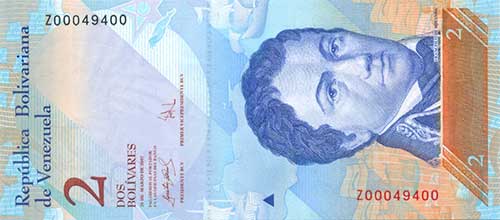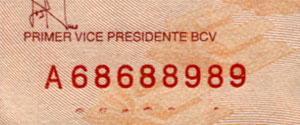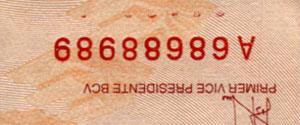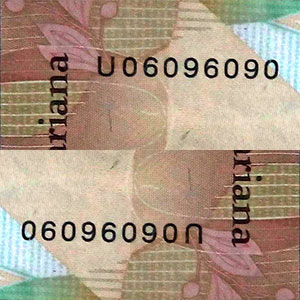
A proposal from this website to calculate the amount of piece to be considered as High serial number or Low serial number based on the amount of issues (oficial or estimated) of a serie. There are three amount of pieces based loosely on known criterias, which maybe used as levels.
The amount of each level includes pieces of higher levels, so to know the amount of each level, it's necessary to substract the amount of pieces from higher levels.
The amount of calculated pieces is not directly proportional to the amount of issues, instead, it's relative with a behavious which is less issues-more pieces, and more issues-less pieces.
The formula is based on a maximum amount of pieces based on 90.000.000 issues, which is:
amount_pieces = issues_amount ( LOG(maximum) / LOG(90000000) ), which is equal to:
amount_pieces = issues_amount ( LOG(maximum) / 7,95424 )
A.- First Level
Based on a known criteria of 10.000 pieces taken from the maximum number of piece using the half amount of 8 digits serie (4 digits). This level without substracting the higher levels amount of pieces can be used to know the general amount of low or high serial number. The relative amount of piece can be calculated using the following formula:
amount_pieces = issues_amount ( LOG(10000) / 7,95424 ), which is also the same to:
amount_pieces = issues_amount ( 4 / 7,95424 ) = issues_amount ( 0,50288 )
B.- Second Level
Based on the criteria of the first 4.000 pieces (1
brick, 4
bundles, 400
straps) and can be calculated using the folowwing formula:
amount_pieces = issues_amount ( LOG(4000) / 7,95424 ), which is equal to:
amount_pieces = issues_amount ( 3,60206 / 7,95424 ) = issues_amount ( 0,45284 )
C.- Third Level
Based on the criteria of the first 1.000 pieces (1
bundle, 10
straps) and can be calculated using the following formula:
amount_pieces = issues_amount ( LOG(1000) / 7,95424 ), which is also the same to:
amount_pieces = issues_amount ( 3 / 7,95424 ) = issues_amount ( 0,37716 )
D.- Fourth Level
Based on the criteria of the first 100 pieces (1
strap) and can be calculated using the following formula:
amount_pieces = issues_amount ( LOG(100) / 7,95424 ), which is also the same to:
amount_pieces = issues_amount ( 3 / 7,95424 ) = issues_amount ( 0,37716 )
 It's a banknotes which serial number can be read the same forward or backward. This is also known as palindromic number. There are 1 radar banknotes for each 10,000 pieces (based on a 8-digits serie and 90,000,000 pieces), and varies depending the serial interval and amount of digits.
It's a banknotes which serial number can be read the same forward or backward. This is also known as palindromic number. There are 1 radar banknotes for each 10,000 pieces (based on a 8-digits serie and 90,000,000 pieces), and varies depending the serial interval and amount of digits. A proposal from this website to calculate the amount of piece to be considered as High serial number or Low serial number based on the amount of issues (oficial or estimated) of a serie. There are three amount of pieces based loosely on known criterias, which maybe used as levels.
A proposal from this website to calculate the amount of piece to be considered as High serial number or Low serial number based on the amount of issues (oficial or estimated) of a serie. There are three amount of pieces based loosely on known criterias, which maybe used as levels. A banknote with a sequence of digits within the serial number repeats itself, for example "423423", "25252525" and "758758758". The amount of repeater digits depends the length of the serial number, for example:
A banknote with a sequence of digits within the serial number repeats itself, for example "423423", "25252525" and "758758758". The amount of repeater digits depends the length of the serial number, for example: Banknote that is used to replace defective or low quality printed banknotes. It usually has an special serial number to distinguish among others. Generally the quantity is low, so it is very scarce and the numismatic value is higher than normal banknotes.
Banknote that is used to replace defective or low quality printed banknotes. It usually has an special serial number to distinguish among others. Generally the quantity is low, so it is very scarce and the numismatic value is higher than normal banknotes.
 A banknote with serial number that can be read the same rotating upside down. The digits of the serial number that allow this are "0", "6", "8" and "9".
A banknote with serial number that can be read the same rotating upside down. The digits of the serial number that allow this are "0", "6", "8" and "9".

